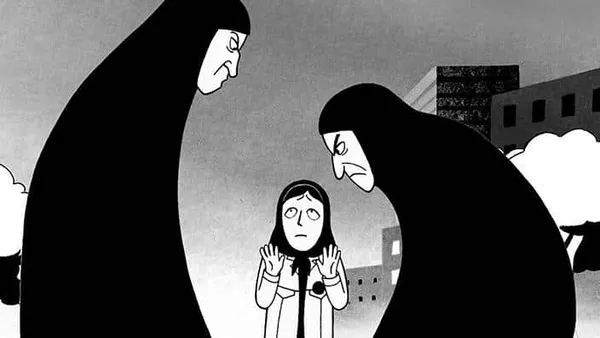Eye For Film >> Movies >> Persepolis (2007) Film Review

A modern young woman enters Paris' Orly airport, dons a veil in the bathroom, and joins a queue for flights to Tehran – but just as she is about to purchase her ticket, she freezes, retreats, and sinks disconsolately into a bench. She can no longer bring herself to return to her homeland, but her memories take her back there anyway - back to her childhood, to a life lived under both the Shah and the Iranian Revolution, under both the repressive restrictions of the Persian state and the costly freedoms of the West.
So begins Marjane Satrapi and Vincent Paronnaud's animated feature Persepolis, based on Satrapi's series of four autobiographical graphic novels – but rather than coating its viewers in sentimental treacle or alienating them with cultural exotica, it races along, as fast as memory itself, through a story that is all at once deeply personal and highly political, as well as being compellingly universal (in the way that only local stories can be), and utterly rock-and-roll.

It is 1978, and as the Shah enjoys his last days governing Iran, impressionable nine-year-old Marjane dreams of Bruce Lee, shaving her legs one day, and becoming the last prophet. She has inherited her family's outspoken irreverence and boldness, but given that these very qualities saw her grandfather executed and her uncle imprisoned for years, she causes her parents endless worries. The initial optimism that accompanies the Islamic Revolution soon turns to fear, as the selfsame leftist intellectuals who were once deemed enemies of the Shah now become the targets of Khomeini's forces, and with the Iran-Iraq war in full swing and internal repression on the increase, the rebellious Marjane is sent to school in Austria by her concerned parents.
Spending her teens in this alien environment, Marjane slowly learns to embrace her Iranian identity, and falls in and out of love for the first time – but a personal crisis brings her back to post-war Iran, where over several years she goes through clinical depression, attends art school, finds her true voice, marries and divorces, before leaving Iran – and her beloved grandmother – forever, without ever quite letting go of either.
Drawn, like its comicbook source, in black-and-white, with colour glimpsed only in the framing scenes at Orly, Persepolis pushes traditional animation techniques to their absolute limits. The film's visuals combine an inchoate brand of punkish realism with the angular distortions of expressionism, while the occasional sub-narrative or dream sequence (Marjane in the clouds hobnobbing with God and Karl Marx, etc) admits some altogether more extravagant stylisations. Seen purely in aesthetic terms, Persepolis is an object of rare beauty, with no obvious precedents or parallels in the history of anime.
The film, however, deserves praise for far more than just its good looks. Although it deals with material that could so easily become mawkish, Persepolis instead remains sharp, pacy and always surprising, thanks largely to a smart protagonist-narrator who welcomes self-deprecation while always rejecting the mantle of victimhood. There is, to be sure, an illuminating (if cursory) history of 20th century Iran to be found here, as well as of the West's insalubrious involvement in that history (dissuading the Shah from his Republican ambitions, training his torturers, arming both sides of the brutal Iran-Iraq War) – but it is always filtered through the perspective of an ordinary family whose other ties, interests and emotions are of equal concern to the filmmakers, so that what might in other hands have been ethnographic agitprop is instead an engaging, character-based tragicomedy, grounded in what might be called the politics of real people.
Satrapi's film may be set in Tehran (and Vienna, and a Parisian airport lounge), but it is named after another city altogether, an ancient Persian metropolis long since reduced to ruins – and sure enough, the film's settings, though very real, are also buried in the distant past (or in the mind). They are places in which one's whole being is rooted but to which one cannot easily return – and the truth is that anyone who has once been a child carries with them their own personal Persepolis. Satrapi's story of adolescence and exile makes indivisible the growing pains of a girl, of an artist and of a nation, as all three struggle towards emancipation and a 'normal life'.
In the end, we do see Marjane shaving (or at least waxing) her legs – but more importantly, by giving full expression, both in her graphic novels and now in this film, to her strong (if somewhat complicated) sense of Iranian identity, she has also realised her childhood dream of becoming a prophet, speaking out for a people whose own speech is not always so free. Yet, as Marjane puts it herself, "freedom always has a price", and though there are certainly gains to be counted from her self-imposed expatriation, this delicately bittersweet film focuses much more on what has been lost.
Reviewed on: 21 Feb 2008


















